Search
Search for "click":
(Click here to search this entire website for "click" with Google.)
 |
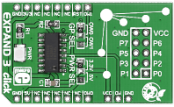
|
|
EXPAND 3 click carries DS2408, an 8-channel programmable I/O expander that communicates with the target board MCU through a standard Dallas Semiconductor 1-Wire interface (15.3 kbps or 100kbps). The chip also has a factory-lasered 64-bit registration number, which enables multiple EXPAND 3 clicks to be connected on the same data line. For this purpose, the click has additional three pins above the mikroBUS socket. As for the socket, the onboard GP SEL jumper allows you to specify the communication pins (either OW1 or OW0, which are in place of the usual AN and PWM pins on mikroBUS). An additional reset line (RST) is also connected. The board is designed to use either a 3.3V or 5V power supply. |
|
|
|
 |

|
|
Expand 4 click carries TPCIC6A595, a chip that combines an 8-bit serial-in, parallel-out shift register with an 8-bit D-type storage register. |
|
|
|
 |

|
|
Flash 2 click is a mikroBUS add-on board for adding more Flash Memory to your target board microcontroller. It carries Microchip's SST26VF064B flash-memory module with 64 Mbits capacity. It's a highly reliable module with a specified minimum of 100,000 read and write cycles and with over 100 years of Data Retention. For data security, the module features a One-Time Programmable (OTP) 2 KB bit secure ID and a 64 bit unique, factory pre-programmed identifier. Additional software security measures include inidividual-block write Protection with permanent lock-down capability. Flash 2 click communicates with the target MCU through the mikroBUS SPI interface (CS#, SCK, MISO, MOSI) with additional functionality provided by the #HOLD pin (in place of default mikroBUS™ RST pin). The board is designed to use a 3.3V power supply. |
|
|
|
 |
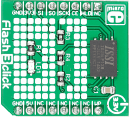
|
|
Flash 3 click is a mikroBUS add-on board for adding more Flash Memory to your target board microcontroller. It carries an ISSI IS25LP128 IC with 128 Mbit capacity.
The high-performance Flash chip operates at 50MHz at Normal and 133MHz at Fast Read speeds.
It is specified to standard 100,000 erase/program cycles with more than 20 years of data retention. The data can be erased in sectors or blocks and programmed with 1 to 256 bytes per page.
Each chip has a 128-bit unique ID for each device.
Flash 3 communicates with the target board through the mikroBUS SPI interface with additional functionality provided by HOLD, CE and WP pins. It is designed to use a 3.3V power supply only. |
|
|
|
 |

|
|
Flash 4 click is a perfect solution for the mass storage option in various embedded applications. With fast performance being one of its key features, Flash 4 click can also be used for the code shadowing, execute-in-place (XIP), and data storage. It features the S25FL512S Flash memory module made by combined high-performance MirrorBit® technology and Eclipse™ architecture. The 512 Mbit SPI Flash memory module is one of the fastest and most reliable Flash modules on the market.
It comes in the package which also includes the mikroSDK™ software and a library with all the functions. The Click board™ comes as a fully tested and approved prototype, making it a reliable device ready to use on the development board. |
|
|
|
 |
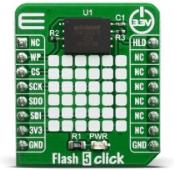
|
|
Flash 5 Click is a perfect solution for the mass storage option in various embedded applications. It features the W25N01GVZEIG/IT (1G-bit) Serial SLC NAND Flash Memory from Winbond which provides a storage solution for systems with limited space, pins and power. The W25N SpiFlash family incorporates the popular SPI interface and the traditional large NAND non-volatile memory space. They are ideal for code shadowing to RAM, executing code directly from Dual/Quad SPI (XIP) and storing voice, text and data.
The Flash 5 click is supported by a mikroSDK compliant library, which includes functions that simplify software development. This Click board™ comes as a fully tested product, ready to be used on a system equipped with the mikroBUS™ socket.
|
|
|
|
 |

|
|
FLICKER click toggles a relay on and off at time intervals which are adjustable with the on-board potentiometers. It is a simple solution if you need to turn a device on and off at specific time intervals, like blinking LED commercials, alarm system lights, or any other signalling lights. |
|
|
|
 |
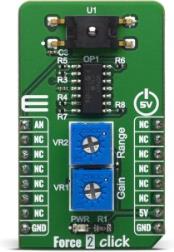
|
|
Force 2 Click is a mikroBUS™ add-on board with circuitry for implementing Honeywell's FSS1500NGT Series force sensors into your projects (with a single zone force sensing resistor included with the click). This Click board™ utilizes FSS1500NGT force sensor which is designed to be one of the most reliable force sensor available as illustrated by 20 million Mean Cycles to Failure (MCTF) at 25 °C [77 °F] rating. This low profile Surface Mount Technology (SMT) sensor allows for automated assembly on a printed circuit board, often helping the customer to reduce assembly costs, while maintainging precise and reliable force sensing performance in a compact commercial-grade package.
Force 2 Click is supported by a mikroSDK compliant library, which includes functions that simplify software development. This Click board™ comes as a fully tested product, ready to be used on a system equipped with the mikroBUS™ socket.
|
|
|
|
 |
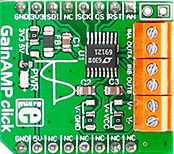
|
|
GainAMP click carries the LTC®6912 dual channel, low noise, digitally programmable gain amplifier (PGA). The click is designed to work on either 3.3V or 5V power supply. It communicates with the target MCU over SPI interface, with additional functionality provided by the following pins on the mikroBUS™ line: AN, RST. |
|
|
|
 |

|
|
GSM-GPS click is a mikroBUS add-on board with a SIM808 module that combines GSM/GPRS and GPS into a single device. Ideal for remote tracking devices in any shape or form.
The high-performance GSM/GPRS engine works on GSM, EGSM, DSC and PCS frequencies. The GPS has a 1 second TTF (Time To First Fix) from a hot start and 30 seconds from a cold start. Tracking sensitivity is -165 dBm.
The board has two antenna connectors, one for GSM the other for GPS. The bottom side has a SIM card slot and a Micro USB connector for interfacing with a PC.
GSM-GPS click communicates with the target board MCU through mikroBUS UART interface, with additional functionality provided by STAT, PWRKEY, RTS, RS, and CTS. Beside the mikroBUS, the board has additional pins for connecting speakers and a microphone to the GSM engine.
GSM-GPS click uses either a 3.3V or 5V power supply. |
|
|
|
 |
|
<< First
< Previous
Next >
|
|

